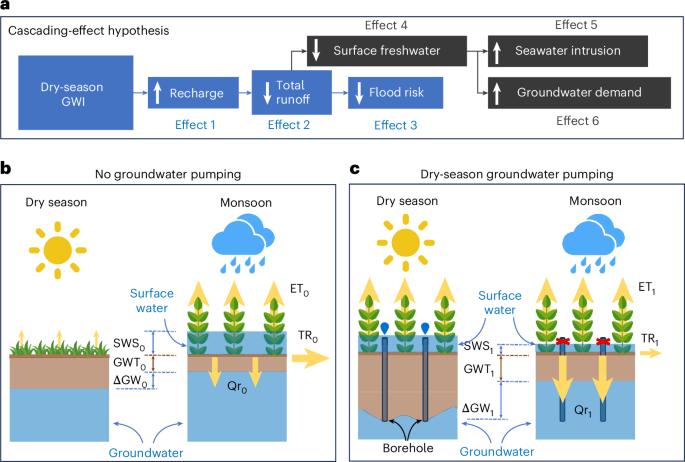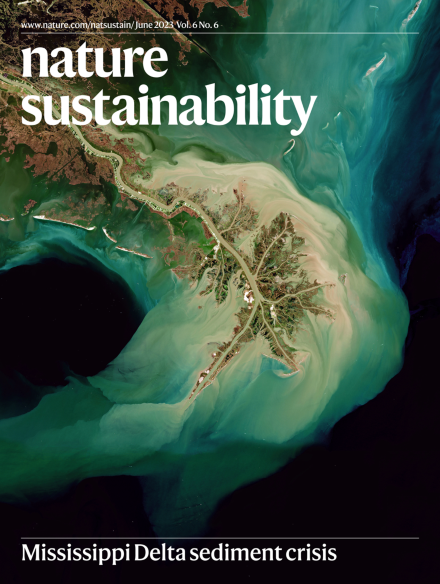Deltaic freshwater scarcity driven by unsustainable groundwater-fed irrigation
IF 27.1
1区 环境科学与生态学
Q1 ENVIRONMENTAL SCIENCES
引用次数: 0
Abstract
Southern Asia benefits from groundwater pumping for dry-season irrigation by increasing both crop productivity and monsoon aquifer recharge rates in the region. On the basis of a data-driven integrated modelling system, we provide numerical evidence that the impacts of unsustainable groundwater-fed irrigation on surface freshwater availability go beyond what was previously understood. Our results confirm findings from previous studies showing increased groundwater recharge rates during wet seasons over 2002–2021, but these rates are insufficient for aquifers to recover, gradually depleting groundwater across the Ganges–Brahmaputra–Meghna delta. The main findings are that this increased recharge causes a drop in surface runoff and baseflow generation during the monsoons, resulting in lower flood risk (a beneficial outcome), but also less surface freshwater available for farming, which may trigger additional groundwater demand. The drop in coastal flood risk induced by inland groundwater-fed irrigation exceeds the increase caused by sea level rise by about five- to tenfold. Reduced runoff may also increase seawater intrusion, driven by less freshwater to push ocean water away, further increasing freshwater scarcity. This is particularly concerning, since the region has been under rising sea levels and sinking lands. Our findings over this delta have global implications, as humans and climate are increasingly pressuring coastal and deltaic ecosystems worldwide. Dry-season groundwater irrigation in southern Asia increases annual agricultural productivity while monsoon rains recharge aquifers. However, groundwater irrigation rates in the Ganges–Brahmaputra–Meghna delta exceed monsoonal recharge rates, reduce available surface freshwater and increase the risk of saltwater intrusion.

由不可持续的地下水灌溉导致的三角洲淡水短缺
南亚从抽取地下水用于旱季灌溉中受益,因为它提高了该地区的作物生产力和季风含水层补给率。在数据驱动的综合建模系统的基础上,我们提供了数值证据,表明不可持续的地下水灌溉对地表淡水可用性的影响超出了以前的理解。我们的研究结果证实了之前的研究结果,即2002-2021年雨季地下水补给率增加,但这些速率不足以使含水层恢复,从而逐渐耗尽恒河-雅鲁藏布江-梅克纳三角洲的地下水。主要发现是,这种增加的补给导致季风期间地表径流和基流产生的减少,导致洪水风险降低(一个有益的结果),但也减少了可用于农业的地表淡水,这可能引发额外的地下水需求。由内陆地下水灌溉引起的沿海洪水风险的下降超过了海平面上升引起的增加大约五到十倍。径流减少还可能增加海水入侵,因为淡水减少会将海水推开,从而进一步加剧淡水短缺。这尤其令人担忧,因为该地区一直处于海平面上升和陆地下沉的情况下。随着人类和气候对全球沿海和三角洲生态系统的压力越来越大,我们对这个三角洲的发现具有全球意义。南亚旱季的地下水灌溉提高了年农业生产力,而季风降雨则补充了含水层。然而,恒河-布拉马普特拉河-梅克纳河三角洲的地下水灌溉率超过了季风补给率,减少了可用的地表淡水,增加了盐水入侵的风险。
本文章由计算机程序翻译,如有差异,请以英文原文为准。
求助全文
约1分钟内获得全文
求助全文
来源期刊

Nature Sustainability
Energy-Renewable Energy, Sustainability and the Environment
CiteScore
41.90
自引率
1.10%
发文量
159
期刊介绍:
Nature Sustainability aims to facilitate cross-disciplinary dialogues and bring together research fields that contribute to understanding how we organize our lives in a finite world and the impacts of our actions.
Nature Sustainability will not only publish fundamental research but also significant investigations into policies and solutions for ensuring human well-being now and in the future.Its ultimate goal is to address the greatest challenges of our time.
 求助内容:
求助内容: 应助结果提醒方式:
应助结果提醒方式:


